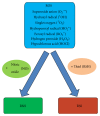Antioxidant Intake and Antitumor Therapy: Toward Nutritional Recommendations for Optimal Results
- PMID: 26682013
- PMCID: PMC4670692
- DOI: 10.1155/2016/6719534
Antioxidant Intake and Antitumor Therapy: Toward Nutritional Recommendations for Optimal Results
Abstract
The role of the induction of oxidative stress as the mechanism of action of many antitumor drugs is acquiring an increasing interest. In such cases, the antitumor therapy success may be conditioned by the antioxidants present in our own body, which can be synthesized de novo (endogenous) or incorporated through the diet and nutritional supplements (exogenous). In this paper, we have reviewed different aspects of antioxidants, including their classification, natural sources, importance in diet, consumption of nutritional supplements, and the impact of antioxidants on health. Moreover, we have focused especially on the study of the interaction between antioxidants and antitumor therapy, considering both radiotherapy and chemotherapy. In this regard, we found that the convenience of administration of antioxidants during cancer treatment still remains a very controversial issue. In general terms, antioxidants could promote or suppress the effectiveness of antitumor treatment and even protect healthy tissues against damage induced by oxidative stress. The effects may depend on many factors discussed in the paper. These factors should be taken into consideration in order to achieve precise nutritional recommendations for patients. The evidence at the moment suggests that the supplementation or restriction of exogenous antioxidants during cancer treatment, as appropriate, could contribute to improving its efficiency.
Figures



Similar articles
-
Efficacy and Interaction of Antioxidant Supplements as Adjuvant Therapy in Cancer Treatment: A Systematic Review.Integr Cancer Ther. 2016 Mar;15(1):17-39. doi: 10.1177/1534735415610427. Epub 2015 Oct 26. Integr Cancer Ther. 2016. PMID: 26503419 Free PMC article.
-
[Effect of antioxidant supplementation over oxidative stress and quality of life in cervical cancer].Nutr Hosp. 2011 Jul-Aug;26(4):819-26. doi: 10.1590/S0212-16112011000400023. Nutr Hosp. 2011. PMID: 22470030 Clinical Trial. Spanish.
-
Strategies for reducing or preventing the generation of oxidative stress.Oxid Med Cell Longev. 2011;2011:194586. doi: 10.1155/2011/194586. Epub 2011 Dec 10. Oxid Med Cell Longev. 2011. PMID: 22191011 Free PMC article. Review.
-
Antioxidant supplements during cancer treatments: where do we stand?Clin J Oncol Nurs. 2001 Jul-Aug;5(4):181-2. Clin J Oncol Nurs. 2001. PMID: 12690623 Review.
-
Protective role of vitamin E on the oxidative stress in Hansen's disease (Leprosy) patients.Eur J Clin Nutr. 2005 Oct;59(10):1121-8. doi: 10.1038/sj.ejcn.1602221. Eur J Clin Nutr. 2005. PMID: 16015260 Clinical Trial.
Cited by
-
Recent Advances in Anti-Metastatic Approaches of Herbal Medicines in 5 Major Cancers: From Traditional Medicine to Modern Drug Discovery.Antioxidants (Basel). 2021 Mar 27;10(4):527. doi: 10.3390/antiox10040527. Antioxidants (Basel). 2021. PMID: 33801741 Free PMC article. Review.
-
The Influence of Nutritional and Lifestyle Factors on Glioma Incidence.Nutrients. 2020 Jun 17;12(6):1812. doi: 10.3390/nu12061812. Nutrients. 2020. PMID: 32560519 Free PMC article. Review.
-
Study of the Radiosensitizing and Radioprotective Efficacy of Bromelain (a Pineapple Extract): In Vitro and In Vivo.Integr Cancer Ther. 2020 Jan-Dec;19:1534735420950468. doi: 10.1177/1534735420950468. Integr Cancer Ther. 2020. PMID: 32783540 Free PMC article.
-
Antioxidants for the Treatment of Breast Cancer: Are We There Yet?Antioxidants (Basel). 2021 Jan 31;10(2):205. doi: 10.3390/antiox10020205. Antioxidants (Basel). 2021. PMID: 33572626 Free PMC article. Review.
-
The importance of antioxidants and place in today's scientific and technological studies.J Food Sci Technol. 2019 Nov;56(11):4757-4774. doi: 10.1007/s13197-019-03952-x. Epub 2019 Jul 29. J Food Sci Technol. 2019. PMID: 31741500 Free PMC article. Review.
References
-
- Halliwell B., Gutteridge J. M. C., Cross C. E. Free radicals, antioxidants, and human disease: where are we now? The Journal of Laboratory and Clinical Medicine. 1992;119(6):598–620. - PubMed
-
- Khlebnikov A. I., Schepetkin I. A., Domina N. G., Kirpotina L. N., Quinn M. T. Improved quantitative structure-activity relationship models to predict antioxidant activity of flavonoids in chemical, enzymatic, and cellular systems. Bioorganic and Medicinal Chemistry. 2007;15(4):1749–1770. doi: 10.1016/j.bmc.2006.11.037. - DOI - PMC - PubMed
Publication types
MeSH terms
Substances
LinkOut - more resources
Full Text Sources
Other Literature Sources
Medical

